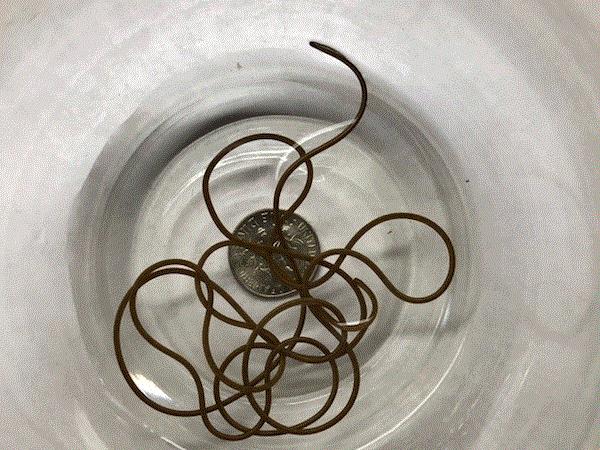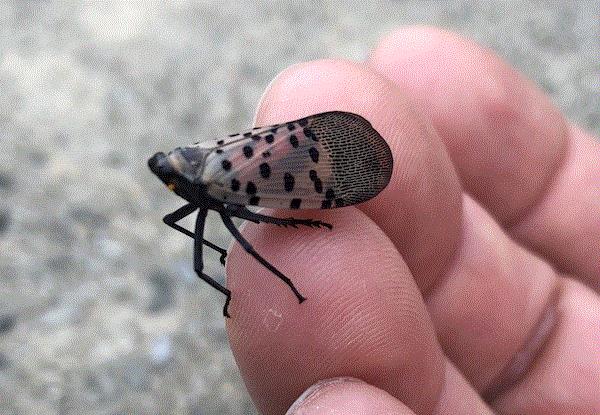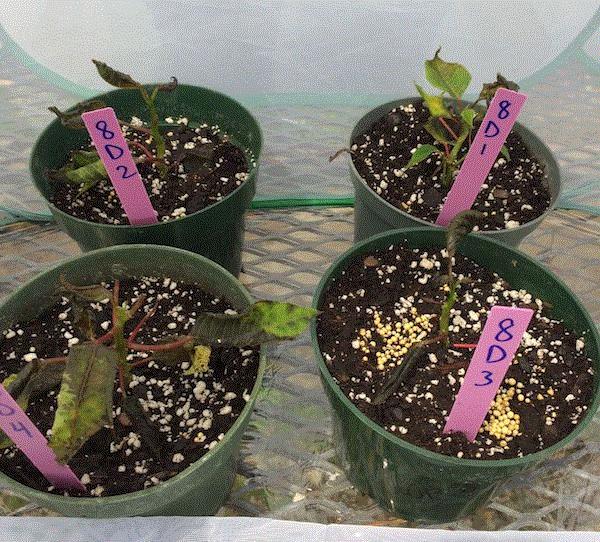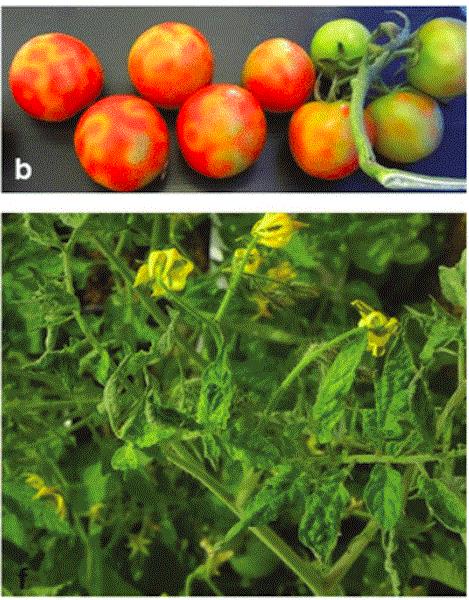What the ... ?
Dewey Ervin, a great neighbor and family friend, asked me to identify a creature. At first glance, calling it a “creature” seemed a bit far-fetch because it looked merely like a long, thin brown string in a cup of water with a dime. (It was “about 2 mm in diameter and over 20 cm long,” reported Dewey.)
Just to show that he wasn’t pulling my leg, I supposed, Dewey also sent a video of the same creature. The creature moved its “head” ever so slightly during the 22-second video to show that it was alive.

It wiggles! (Photo credit: Dewey Ervin.)
I knew almost immediately what it was. It was my lovely wife that actually uttered, “What the … eww?” after seeing the picture.
What is it? The answer is at the end of this newsletter.
Spotted Lanternfly Webinar Recording is Now Available
I attended the Spotted Lanternfly (SLF) webinar, presented by Brian Walsh of Penn State University Extension and hosted by the Horticultural Research Institute as part of its tHRIve webinar series, on November 17. It was a great webinar, with lots of updates, and new research results and observations. Brian is the Extension Educator in Berks County, Pennsylvania, the Ground Zero of SLF invasion. He's seen it all.
Don't worry if you missed the webinar. A recording, as well as a list of questions and answers are now freely accessible on HRI’s tHRIve webinar series website. While you’re at the website, consider a contribution to HRI to continue its research and education missions.
During the webinar, one thing that struck me right off the bat was how much hype is associated with SLF. That’s no surprise. If I’m swamped by biblical proportions of brightly colored insects with the potential to cause my crops harm, I’d be scared, too. Not to mention that I’m an entomologist—any crazy bug sends tingles down my spine.

Ain't she a beauty? (Photo credit: David Coyle, Clemson University.)
One of Brian’s goals was to debunk myths surrounding SLF. I think Brian was pretty successful—some of my previous assumptions were definitely challenged. I’ve prepared a recap of the webinar for the January issue of GrowerTalks. Check it out when it arrives at your desk or digital device.
I’ll give you a “lite” version of the debunked myths in this newsletter:
-
New economic analysis suggest that SLF’s economic impact is lower than the oft-cited $18 billion
-
SLF isn't established throughout the United States even though individual finds were reported from coast to coast; the potential of spread is definitely there, so stay vigilant
-
It may be an unpleasant surprise to those who think they can outrun SLF—these bugs can walk, hop and fly
-
SLF is not a tree killer, but lots of other issues can result from its feeding
-
Tree of heaven is important to SLF biology, but it’s not essential
-
The values of trap trees and egg scalping as management approaches may be debatable
SLF is such a new invasive pest that lots of questions are yet to be answered. I look forward to reading research results by folks at Penn State and other agencies.

Dos and Don'ts of Horticultural Oil
I’ve gotten several inquiries in only the past three weeks from folks I met during my speaking tours or site visits, or through this newsletter about using oil for dormant or clean-up treatment. John Rich and Mark Smith, both readers of this newsletter, drop me a line or two every now and then, reporting great results with using oil in controlling spruce gall midge, azalea lacebug, spider mites, mealybugs and other pests.
I agree with John and Mark—what’s not to love about oil? It’s versatile and can be used in just about any situation. It’s effective against many soft-bodied insects, especially the love of my professional life—mealybugs and scale insects. (Got to be careful with what I call “the love of my life” while my wife and her dog are watching.) Its re-entry interval is only four hours and it’s compatible with biological control, and cheap and widely available, much welcomed by a cheapskate like me.
Pesticidal oils are made of refined petroleum, or mineral oil or vegetable oil, and are used as dormant oil or horticultural (a.k.a. summer) oil. As their names imply, you use dormant oil on dormant plants after winter hardening and before bud breaks, and horticultural oil on growing or dormant plants.
I generally consider neem oil as horticultural oil because azadirachtin, which is the active ingredient in neem, has been removed during the process, leaving neem oil to contain only ... well ... oil. Botanical or essential oils—such as citrus oil, peppermint oil and rosemary oil—still contain plant compounds other than oil. I haven't quite decided if I consider essential oil as horticultural oil or not because the plant compounds in essential oil may be doing something more than what the oil is doing to the pests. More research will be needed to answer that question.
Other than using horticultural oil by itself, I also use it in combination with other pesticides. For example, a mixture of 1% to 2% horticultural oil with an insect growth regulator (pyriproxyfen a.k.a. Distance IGR or buprofezin, a.k.a. Talus 70DF) sprayed around the time of crawler emergence gave very good results against armored scales. A combination of abamectin (Avid) and 1% horticultural oil is effective against eriophyid mites, which are notoriously difficult to control. Dipping poinsettia cuttings with 0.1% horticultural oil is a good way to make sure the cuttings are clean before sticking. Cutting dip keeps poinsettias essentially whitefly-free for weeks.
I also take some precautions when using horticultural oil. Thorough coverage of the pest population is necessary for good efficacy because horticultural oil kills by contact.
There's a caveat with the compatibility of horticultural oil with biological control: biological control agents that step on horticultural oil residue will not be killed, but those sprayed and covered by horticultural oil have just received a death sentence. Check your biological control agent population after oil sprays to decide if additional releases are needed.
The short residual longevity of horticultural oil is a double-edged sword: it allows beneficials to re-colonize quickly, but also means reapplication is needed within one week when there's a constant immigration or reproduction of pests.
One of the major reasons for folks’ reluctance to use horticultural oil is injury to tender growth or some plant species (such as blue spruce). This concern is real, but can be avoided if we follow product label instructions. Don't use horticultural oil if the temperature exceeds 90F (32C) or falls below freezing, humidity stays above 70%, when rain is expected, plants are water-stressed, or plant tissues are wet. Some of these restrictions can be overcome with planning.
I haven’t had plant injury when spraying oil, even in the blazing hot and humid summer of South Carolina. That’s because I spray early in the morning when temperatures are cooler and give time for the spray solution to dry before the temperature reaches 90F. Risk of injury is greater when spray solution sits on the plants.
And, lastly, don't be a dummy: if the label doesn’t specifically allow for a certain application method, don't do it. Exhibit Number One: me. Ultra-Pure Oil label doesn’t allow for dipping of unrooted poinsettia cuttings, but I went ahead and did it. Look what happened within three days of dip! The consequence is all yours to bear if you insist on being a knucklehead. Do a test spray on a group of five to 10 plants and watch for injury before committing to a broadcast.

Using horticultural oil when you're not supposed to? This is what will happen to your plants.

Syngenta Introduces ToBRFV-Resistant Tomatoes
Okay, first, what is ToBRFV? It may not be a familiar acronym if you don't grow tomatoes. If you're a tomato grower, tomato brown rugose fruit virus, or ToBRFV, is a very serious disease and regulatory issue. Read a previous issue of this newsletter (click here) to learn more about ToBRFV.
Syngenta Vegetable Seeds announced on November 30 that its first ToBRFV-resistant tomato variety would be available globally in early 2021. The company uses genetic marker technology to discover resistance genes and screen their collection of germplasm for resistant varieties. This process significantly shortens the time needed to introduce a new variety from 10 years to one.

ToBRFV turns tomatoes ugly and nasty. (Photo credit: Dombrovsky and Smith 2017, Advances in Seed Biology.)
Answer to “What the … ?”
If you guessed the “What the … ?” creature is a worm, you get half a point. If you guess horsehair worm, then you get a full point. Look at it! It looks just like a string of hair! Maybe the old timers were right in thinking that they're horsehairs fallen into water and come to life? Nah.
There are about 300 species of horsehair worms. They’re, simply put, a thing of nightmares. (If you're one of its hosts, that is.) They're an interesting group of parasites. They start their lives as eggs in soil, litter or a body of water, such as streams, ponds or puddles. After hatching, the microscopic baby worm forms a cyst, which it hopes will be ingested by an insect, sowbug or other scavenging arthropod.
For the horsehair worm species that lay eggs in water, the cysts are ingested by terrestrial insects as they take a sip from the water or ingested by aquatic insect larvae then carried away from the water when the aquatic larvae molt into adults. When the adult insects die on land, scavengers enjoy the morsels and ingest the cysts within. Once inside the gut of the scavengers, larvae revert to worm form and bore through the gut into the bodies of the hosts, where they feed until adulthood.
What’s really interesting is that these worms will hijack the nervous system of the hosts, make them go to a secluded location or into the water. Then the worms emerge from the hosts, find each other, mate, lay eggs and restart the cycle. Wired magazine has an interesting piece about horsehair worm.
Then worms form a knotty mass when they emerge from the host or come together. One of the most studied genus, Gordius, derives its generic name from the legend of King Gordius of Phrygia, who tied a complicated knot and declared that the first person to untie the knot will be the ruler of Asia. Alexander the Great, instead of sitting down and enjoying a good 'ole time of puzzle solving, cut through the knot with his sword! Ain’t nobody got time for that! He had a world to conquer! Guess what? The cheater expanded his empire all the way to the Indus River.
Horsehair worms are parasites of arthropods, so they aren’t pests of plants, people or livestock. They are, nonetheless, great for lightening the mood before the holidays, if y’all are more of “The Nightmare Before Christmas” kind of guy like me.
They're a wonderful example of what’s unseen right under our feet.





Have a wonderful holiday season!

JC Chong
Professor of Entomology at Clemson University
This e-mail received by 23,489 subscribers like you!
If you're interested in advertising on PestTalks contact Kim Brown ASAP!